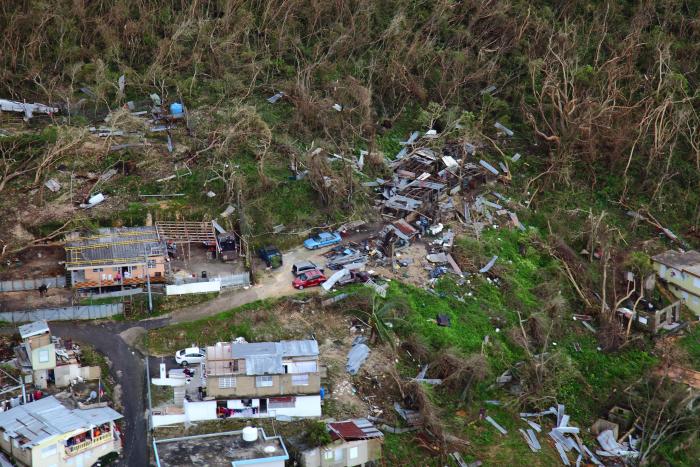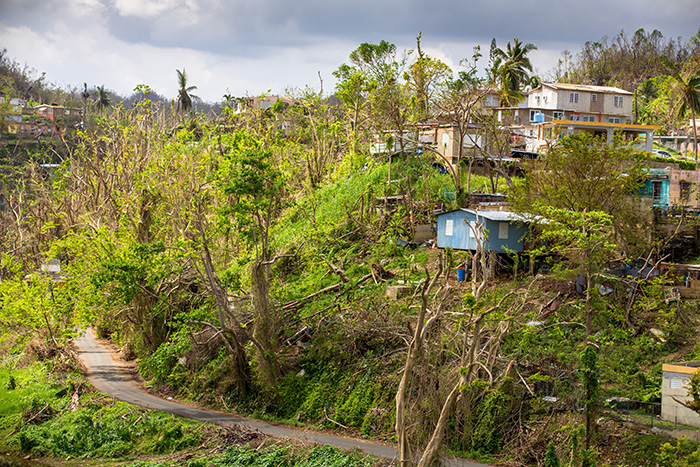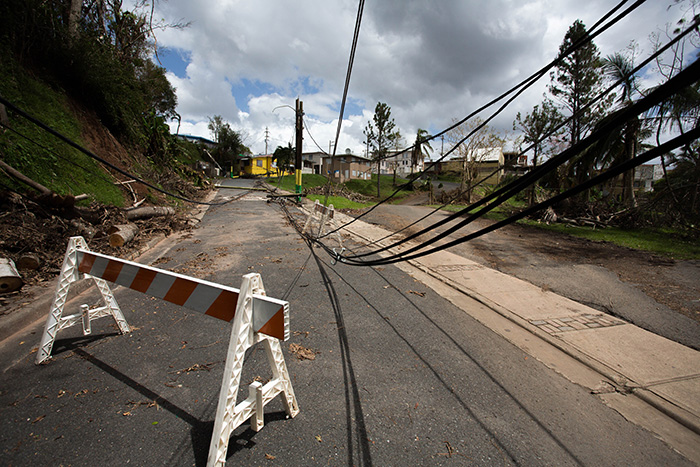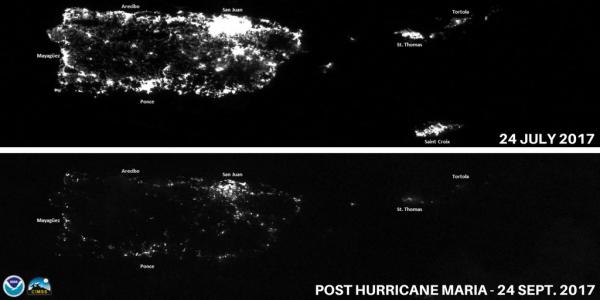Hurricane Maria: September 2017
Hurricane Maria spread wreckage across the Caribbean as she sped toward the island of Puerto Rico. The damage was truly catastrophic in Dominica, where the storm basically flattened scores of homes and flooded others. The photograph below shows just how terrible the damage was there.
Hurricane Maria
Guadeloupe, Martinique, Haiti, and the Virgin Islands also suffered widespread damage. But Maria is almost all about Puerto Rico. The storm made landfall there near Yabucoa on the southeast coast at 10 AM on September 20, 2017. The island was still recovering from Hurricane Irma, which devastated the nearby Virgin Islands and passed to the north of Puerto Rico, but still caused widespread power outages. After Irma, Puerto Rico sent supplies to the Virgin Islands, including water and tarps.
At landfall, winds were clocked at 155 mph, a strong category 4 storm. After landfall winds weakened but the eyewall grew during replacement leading to a larger area of damaging winds. Rainfall caused significant damage, up to 1 meter (38 inches) of rain fell in mountainous areas and much of the eastern half of the island received over 0.4 meters (15 inches). The ground was already saturated as a result of rain from Irma and so this water had nowhere to go. In one notable incident, floodwaters released from the La Plata dam rose up to 4.5 meters (15 feet), caused extensive flooding, and trapped several thousand people. The Guayataca dam was deemed to be at risk of collapse and tens of thousands of people had to evacuate. Flash flooding, mudslides, and landslides were common in mountainous areas, cutting off whole communities. A month after the storm only 640 kilometers (400 miles) of 8000 kilometers (5000 miles) of roads were passable, making getting relief to citizens difficult. Maria destroyed a total of 70,000 homes and damaged up to 300,000 others.
Please take a look at the stunning before and after images from The Guardian, "Puerto Rico six months after Hurricane Maria: then and now" highlighting the impacts and recovery in Puerto Rico. Note that although repairs were completed, most houses pictured have only temporary fixes and blue tarps for roofs.

One of the lessons from Maria was the failure of the power grid. The Puerto Rico power grid was antiquated and extremely vulnerable to a storm like Maria. Lack of funding and years of mismanagement and failure to maintain equipment, combined with damage from previous storms left the grid extremely vulnerable. The national power company, the Puerto Rico Electrical Power Authority (PREPA) was over $7 billion in debt when it filed for bankruptcy months before Maria. Immediately after the storm, the power grid went down for the whole island, leaving 3.4 million people without electricity. Even hospital generators failed. Almost all cell and landline service was down. 90% of the island was still without power a month after the storm, and two months later 1.5 million people were without power. In some places, it took 11 months to restore power! After Maria, the federal government set aside $2 billion to fix the power system, but PREPA has been in bankruptcy negotiations for the last two years, and an earthquake in 2020 again led to widespread blackouts, so problems persist.
Video: Puerto Rico after Hurricane Maria: 'We're American, too, why don't they help?' (9:49)
This video exposes the severity of the poor response to Maria in Puerto Rico
Woman: Everything went like slow motion, like it was like the wizard of oz movie but backwards. You are in the rainbow in oz, the twister and then black and white everything destroyed.
Woman speaking in Spanish - translation: It was like the place had been deserted because there was no way to communicate or to find help. We didn't have water electricity or medicine. It affected our physical health, our emotional wellbeing, and our economy. It has especially affected our safety.
Narrator: Among the most dramatically damaged areas in the capital was La Perla, a small balio near the sea in San Juan. Many homes there were reduced to a roofless jumble.
Man: Puerto Rico remains in a state of crisis.
Woman: Maria. It was a great equalizer. Not for the right reasons. It has made us one.
Trump: I hate to tell you Puerto Rico, but you've thrown our budget a little out of whack because we've spent a lot of money on Puerto Rico and that's fine, we've saved a lot of lives. You can be very proud of all of your people, all of our people, working together.
Narrator: Hurricane Maria hit Puerto Rico last September. It was the worst storm to hit the island in over 80 years. Thousands of homes and businesses were destroyed. And the storm left millions without electricity and water.
Woman: It's horrible to be in that situation where you can't do anything.
Woman: It's very sad. Puerto Rico is destroyed.
Narrator: Puerto Rico is a U.S. Territory. It's citizens, who are Americans, have had to step in where the government has let them down.
Man: Hell. It's just been horrible.
Narrator: More than six months on, at least 150,000 people are still without electricity. And at least 200,000 insurance claims remain open. Vincent used to run a bustling cafe in the center of his village, an hour and a half away from San Juan, the capital. But after the hurricane hit, he was forced to close it down.
Vincent (speaking in Spanish) - translation: If you look here, you can see the damage. The problem is that the electricity only arrived three weeks ago. I can't have the lights on on this side. Because of the rain, they might short circuit. I only use these other ones. We didn't have water either. That stopped us from making or selling food as there isn't adequate hygiene. Up until today, the insurers have yet to visit my business. I've given them all the information and the damage has a value of $40- $45,000 dollars. I try to keep the basics to help the communities that have been left isolated.
Narrator: Vincent is one of the thousands of Puerto Ricans still waiting for insurance payouts. Businesses and organizations are only offered loans not government aid. And the lucky few that have private insurance, like Vincent, are seeing their claims stalled. Of the roughly 45,000 small businesses in Puerto Rico, thousands remain closed following the hurricane. FEMA, the U.S. agency in charge of disaster response, has been criticized by many Puerto Ricans. They say it is failing their island. At least 60% of the 1.2 million FEMA claims have been denied, often because claimants are unable to prove they own their own home. Others say they receive letters from FEMA in English, despite Spanish being the dominant language.
Woman speaking in Spanish - translation: It's been six months since the hurricane and we haven't had any electricity. We are still waiting for it. I fille din the FEMA forms. When they visited m place they took notes of everything I said, about the door, how the water came in, how it came through the ceilings and the bed. Then they sent a later saying I didn't qualify because the damage that we suffered was not connected to the hurricane.
Woman: The mayor of hurricane-ravaged San Juan, Puerto Rico, found herself subjected to a barrage of insults from the President of the United States.
Man: The president lashed out at San Juan's mayor. "Such poor leadership ability by the Mayor of San Juan, and others in Puerto Rico, who are not able to get their workers to help.
Trump: There's a lot of love in this room.
Mayor: And it's not coming from him. There's a lot of disrespect coming from him. The President was disregarding our lives. People were dying. People are still dying. But we don't even know how many people have died from the botched effort. The presumption is that funds are here. We haven't gotten one bloody cent. Only one percent of the population has received the maximum amount of $33,000. FEMA keeps putting these numbers out. Oh, we have given San Juan...you have given San Juan shit. So it isn't that they can't do it. It's that they won't do it. Why? Because our lives don't matter to them. The biggest humanitarian crisis that Puerto Ricans have lived under, for many years, more than 500 years, it's colonialism. It is a powerful weapon of domination on every front. It kind of makes you believe that perhaps you don't deserve to be treated appropriately. We need to be the great equalizers. All of these community efforts have to be brought up to the surface, so that they are not the outliers or something that happens, but that they are the way of life in Puerto Rico.
Narrator: Six months on, the most vulnerable people on the island still feel neglected. Charities say they registered a rise in violence against women as a result of the lack of security and electricity at night, leaving women fearful to leave their homes. One of these women is Sue Hay,
Sue Hay speaking in Spanish - translation: As a transgender person, I can tell you when this happened, the problems with safety were already there, from well before the storm. When the hurricane came these issues were amplified. I was honestly feeling helpless. I did not know whether I was going to wake up alive or simply not wake up. I check the rearview mirror to make sure I am not being followed, to check there aren't any strangers. If there are any strangers and I'm on my own, I'll go for a spin and wait for that person to leave the area, and then I can get to wherever I need to go, but much calmer. And now, one ca at least do their make-up because now there are lights. I survived Hurricane Maria. Great, I am now stronger.
Narrator: In the first month, following the hurricane, the number of 911 calls about domestic violence tripled. And due to the damage caused, many of the organizations that provide front-line services to vulnerable Puerto Rican women and children were forced to close. Only five shelters remain open on the island. One of them is Casa de Lebondad, which is run by Gloria. She is now fighting to change FEMA protocols before the next hurricane season so that the agency can provide them with aid rather than loans to rebuild the shelter.
Gloria, speaking in Spanish - translation: Nothing works here, not even the fans. See, there are no lights. But at Christmas, we still sat the children around the tree and shared the moment together. What is wonderful about what we do here is when we see the happy faces of the children and their mothers. But the lack of electricity for us creates a security problem. And when I mention this now, there's still this feeling of sadness, because there are so many women who really need these services. Six months after the hurricane, it's been a great sacrifice, it has cost us many tears. It has cost us a lot of work.
Drinking water was also hit hard by Maria. Up to 50% of citizens had no running water for several weeks. Sewage treatment plants were inoperable for months. Maria wiped out 80 percent of the crop value in Puerto Rico, about $780 million, destroying sugar cane and fruit trees, coffee plants, and vegetables. The storm was particularly hard on trees, ripping off leaves, and stripping bark. One farmer described losing every single one of his 14,000 plantain trees. Row upon row of crops were destroyed. The island imports about 85% of its food, leaving it very vulnerable to a devastating storm like Maria, however before the storm small farming operations were increasing as were local farmers' markets. The loss of croplands combined with the slow response left citizens without food, hungry, and rationing canned goods. After Maria hit, a Federal Emergency was declared and FEMA assistance began with daily relief flights. The Navy deployed numerous ships to help in the relief. However, the scale of the disaster was daunting, hampered by poor communication and difficulty getting assistance to people who needed it, and the government has been criticized for underestimating the severity of the crisis. All in all the storm caused $90 billion in damage.
Estimating the death toll from Maria has been difficult. Officially, 64 people died as a direct result of the storm. However, power cuts, lack of drinking water, food shortages, and the extremely slow governmental response were responsible for far more deaths, especially of people with underlying health problems. But since some of these deaths might have occurred without the storm, the only way to estimate the number is by comparison with mortality rates in previous years. Numerous universities and investigative reporters have made these comparisons and the estimates are staggering. Up to 3,000 people are thought to have perished in the aftermath of Hurricane Maria, exceeding fatalities in Katrina. Many citizens moved to the mainland US, especially to Florida. Because Puerto Rico is a US Territory and citizens pay some federal taxes including Medicare and social security, the federal government has been blamed for the slow response, and for not providing more immediate relief and long-term financial aid to the island. The response was so inadequate and suffering so significant that the international relief organization Oxfam intervened and provided aid to the island. Although the storms, the location, and the nature of the damage were very different and comparisons are difficult, the response (or lack of) to Maria resembled Katrina to many. And because the majority of people impacted by both of these tragedies were minorities, African Americans in the case of Katrina and Hispanics in the case of Maria, there have been charges of environmental racism in both cases. Certainly, the responses to Harvey and Sandy were far superior. Even now, three years after the storm, blue tarps still dot rooftops all over the island, memories of Maria.



